The Exemplar Program provided two years of support (2005-2007), totaling $150,000 to each of 12 small to midsized arts and cultural organizations nationwide. The organizations were recognized for outstanding cultural work in their communities and in the field, based on their participation in the Animating Democracy program and the Working Capital Fund. Supported by the Ford Foundation, the Exemplar Program aimed to foster a holistic and integrated approach to organizational health, institutional growth, civic engagement, and aesthetic investigation.
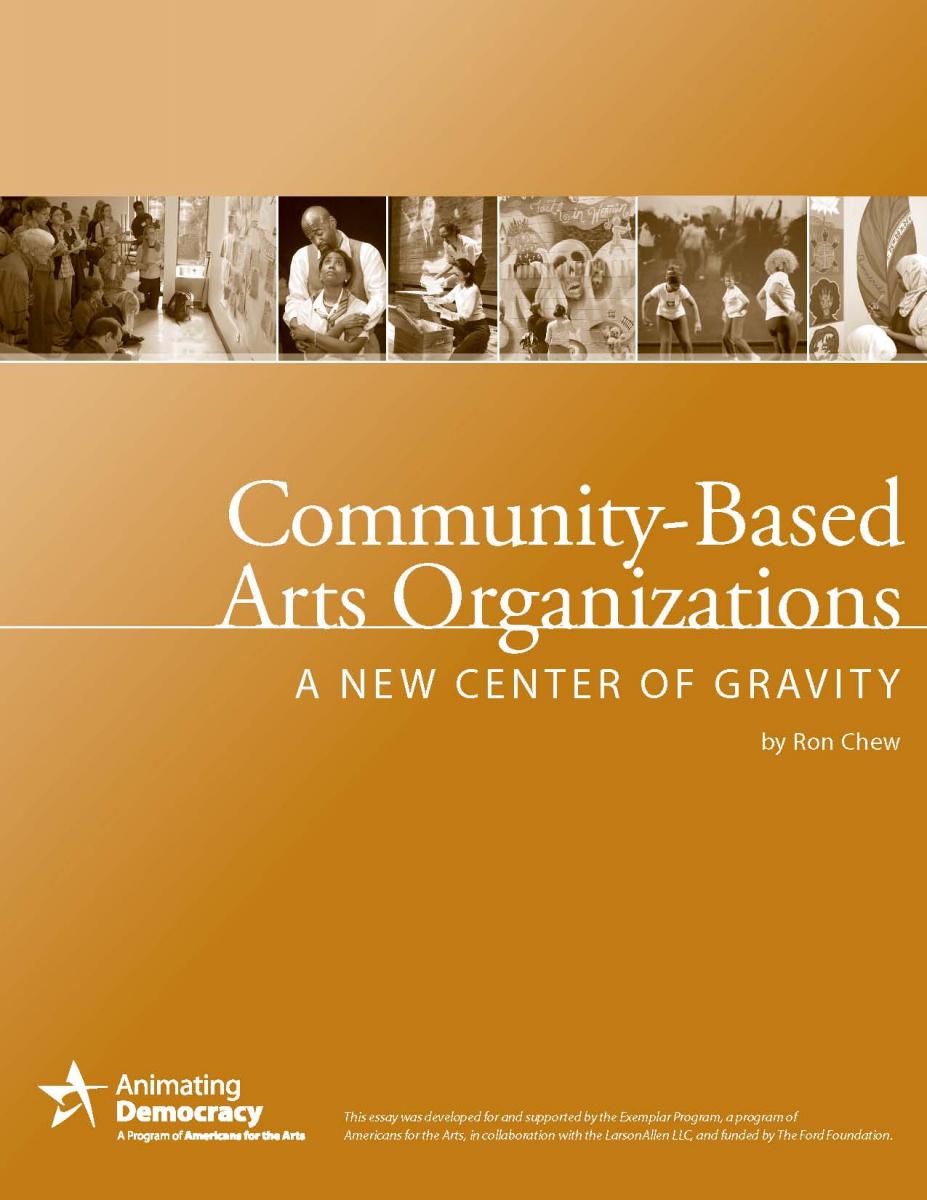 Community-Based Arts Organizations: A New Center of Gravity [PDF]
Community-Based Arts Organizations: A New Center of Gravity [PDF]
by Ron Chew
Summary: Amid changing demographics, a new political climate, technological advances, and globalization, small and mid-sized community-based arts organizations offer artistic excellence and innovation, astute leadership connected to community needs, and important institutional and engagement models for the arts field. As value-based organizations, they are purposeful and have a sustained commitment to fundamental values related to cultural responsibility, ethical practices, and respectful relationships. Attuned to significantly changing demographics, they honor both cultural legacies and future possibilities, understanding them as a continuum, not a contradiction. They often work in partnerships that cross silos and sectors to connect art organically with other areas such as health, community development, humanities, and social justice. They are multilingual in more ways than just language, and their social networks run broad and deep.
This essay by Ron Chew, Principal, Chew Communications and former long-time director of the Wing Luke Asian Museum, makes the case for greater support of this important segment of cultural organizations, exemplified by such organizations as Arte Publico Press in Houston; East Bay Center for the Performing Arts in Oakland, CA; Ma-Yi Theater Company in New York City; and the National Museum of Mexican Art in Chicago. Chew underscores their crucial contributions to the cultural ecosystem, to civic culture, and toward achieving healthy communities and a healthy democracy. This essay was developed for and supported by the Exemplar Program, a program of Animating Democracy in collaboration with the LarsonAllen LLC, with funding from The Ford Foundation.
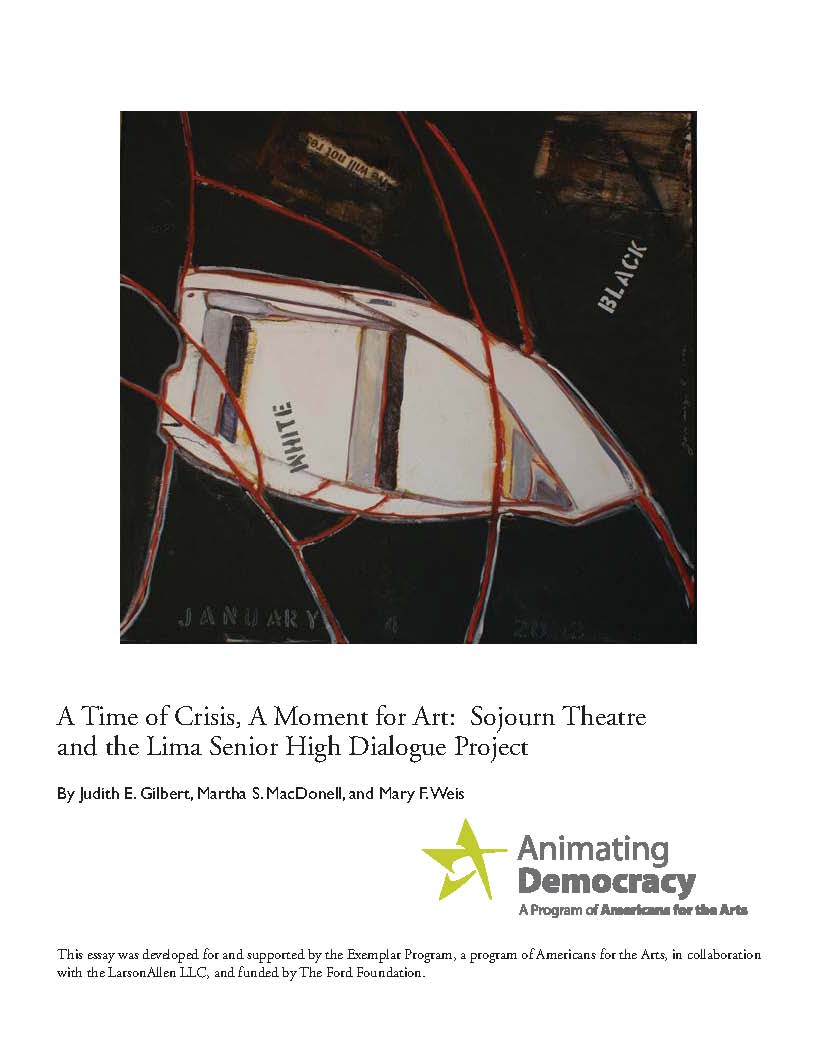 A Time of Crisis, A Moment for Art: Sojourn Theatre and the Lima Senior High Dialogue Project [PDF]
A Time of Crisis, A Moment for Art: Sojourn Theatre and the Lima Senior High Dialogue Project [PDF]
by Judith E. Gilbert, Martha S. MacDonell, and Mary F. Weis
Summary: This case study documents Sojourn Theatre Company’s intervention at Lima, OH, Senior High School following a tragic shooting in 2008 that resurfaced racial tensions in the community. Lima City Schools enlisted Allen County Common Threads, a locally based volunteer group promoting arts-based civic dialogue and Sojourn Theatre Company to implement an immediate arts-based project to help students process the tragedy. Sojourn interviewed students, and wrote, performed, and recorded theatrical monologues expressing student perspectives on the incident and the racial tensions exposed by it. The recorded monologues became the centerpoint for school-wide dialogue facilitated by Common Threads volunteers. The case study describes the role artists can play in a crisis as well as the challenges of the fast pace dictated by crisis. It also underscores the continued value of arts-based civic engagement in this one community over time and the importance of artistic and financial resource for immediate crisis response.
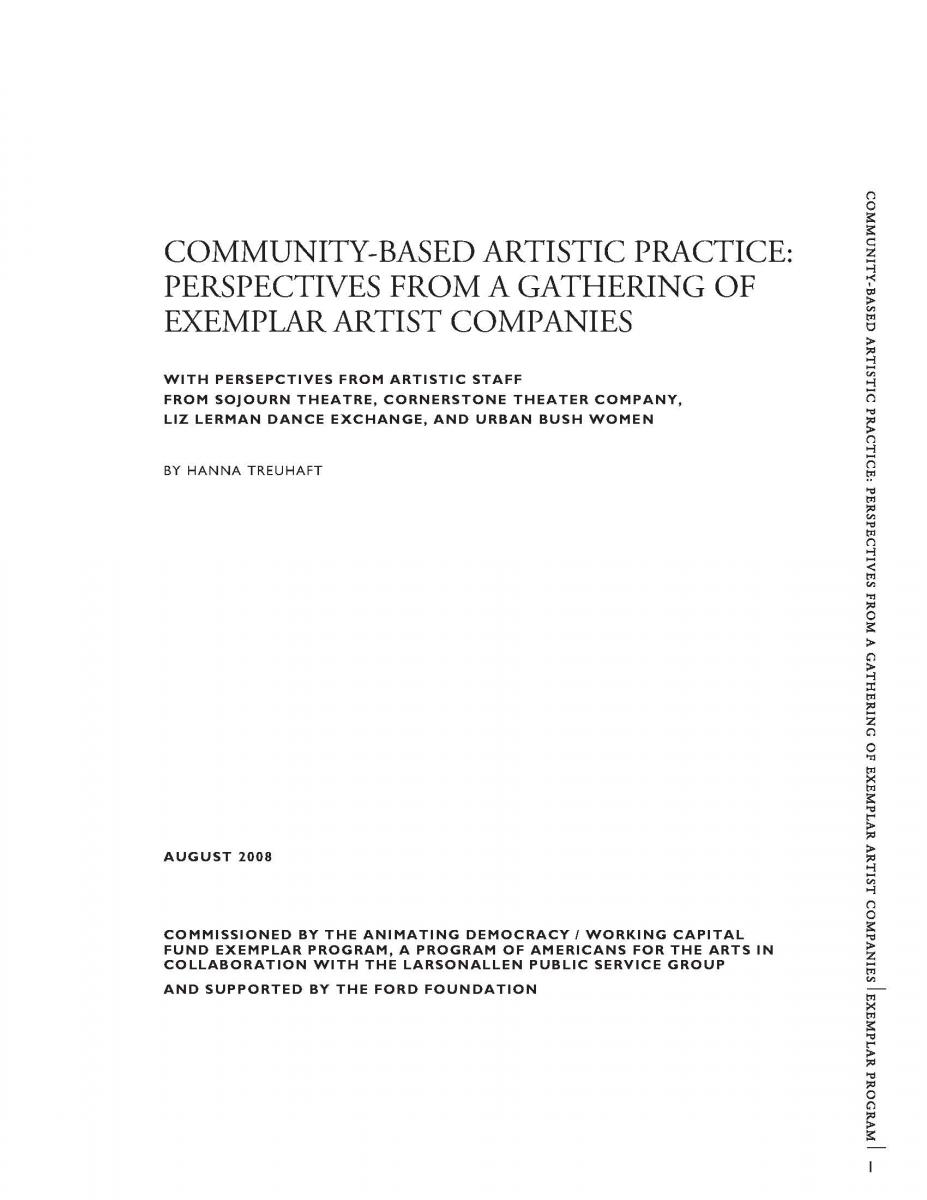 Community-Based Artistic Practice: Perspectives from a Gathering of Exemplar Artist Companies [PDF]
Community-Based Artistic Practice: Perspectives from a Gathering of Exemplar Artist Companies [PDF]
by Hanna Treuhaft
Summary: In November 2007, artistic directors from four artist-led organizations (Cornerstone Theater Company, Liz Lerman Dance Exchange, Sojourn Theatre, and Urban Bush Women) gathered to share ideas about community-engaged art practices, and connection with and responsibility to audiences and young artists. This report, written by Hannah Treuhaft, a company member from Sojourn Theatre and participant at the gathering, recaps and assembles themes and perspective from the four participating organizations. Through discussion, four themes and conversations dominated: 1) methodologies and implications of entering and leaving communities through residency projects, 2) annual training institutes and leadership training for citizen-artist participants, 3) successes and challenges of corporate partnerships as a source of revenue, and 4) arts-based community practice for traveling artist companies and their relationship to their home communities.
 Strategies for Developing Organizational Sustainability: Long-Term Relationships in the Arts
Strategies for Developing Organizational Sustainability: Long-Term Relationships in the Arts
The National Black Arts Festival and The Woodruff Arts Center Partnership Development Project [PDF]
by Mikki Shepard
Summary: To build organizational capacity and provide sustainability, the National Black Arts Festival (NBAF) board and executive staff leadership considered a range of diverse strategies. Recent discussions between NBAF, the Woodruff Arts Center (The Woodruff), and local supporters resulted in a sustainability strategy that would consider a more formal relationship between NBAF and the Woodruff. With this strategy on the table, a research process was launched by NBAF to survey and learn more about the long-term relationships of other arts organizations to inform the negotiation and development of its own relationship with the Woodruff Arts Center and its divisions—the High Museum of Art, Atlanta Symphony Orchestra, Alliance Theatre, and Young Audiences.
The resulting report, Strategies for Developing Organizational Sustainability: Long-Term Relationships in the Arts by Mikki Shepard, shares lessons learned as through a survey of research reports exploring long-term relationships and partnerships between arts organizations. Through the summary of findings, Shepard’s report focuses in detail on the conditions for forming relationships, strategies and process for favorable negotiation, perspective on benefits and challenges of forming partnerships, and reasons for success— and the lessons learned. Though there is no one formula for a navigating successful long-term relationship, the study offers a basis of understanding and provides a selection of areas that arts organizations should explore as they arere considering defining a long-term partnership in their own communities.
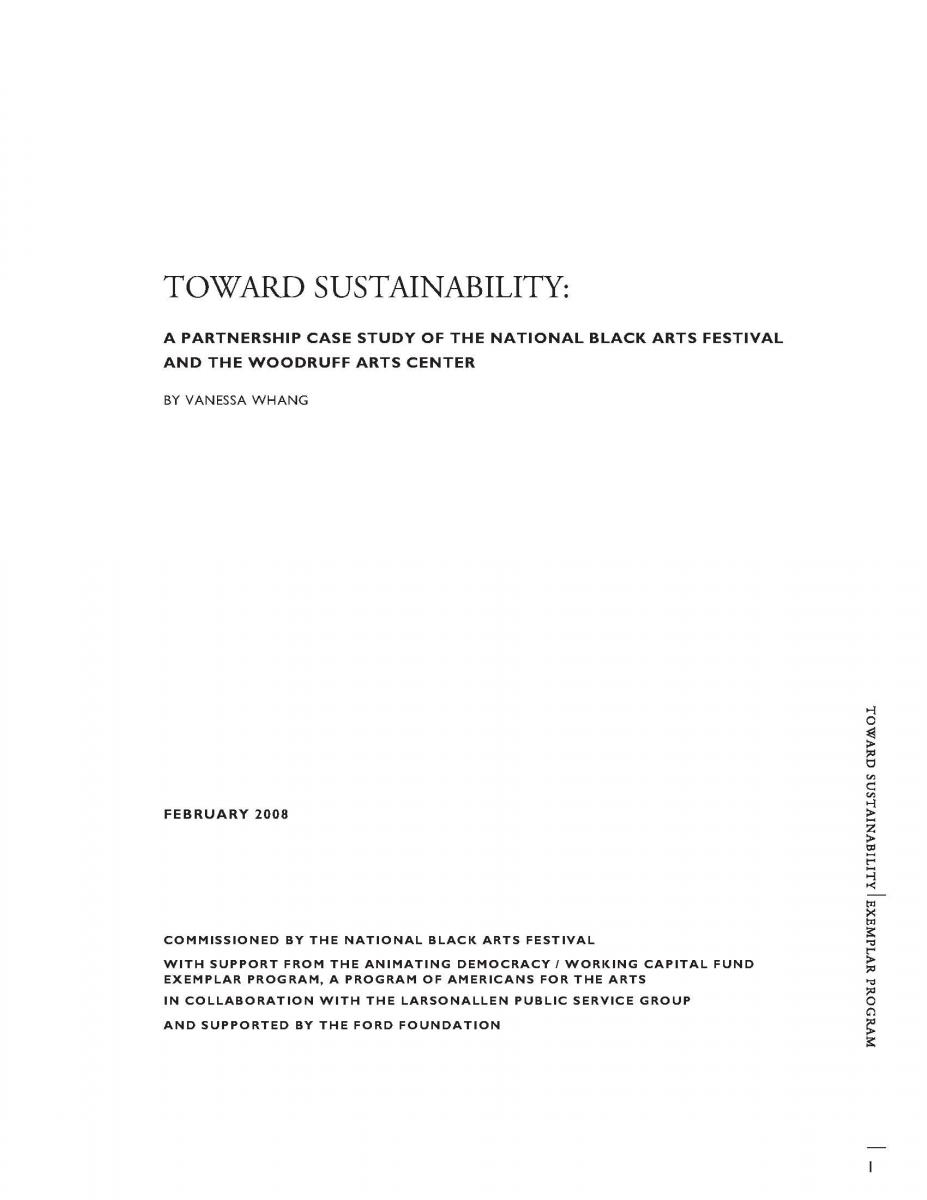 Toward Sustainability: A Partnership Case Study of The National Black Arts Festival and The Woodruff Arts Center [PDF]
Toward Sustainability: A Partnership Case Study of The National Black Arts Festival and The Woodruff Arts Center [PDF]
by Vanessa Whang
Summary: In the spring of 2004, an anonymous donor made a five-year gift to underwrite the National Black Arts Festival’s (NBAF) use of venues on the The Robert W. Woodruff Arts Center’s campus—which includes the Alliance Theatre, Atlanta Symphony Orchestra, High Museum of Art, and Young Audiences. The gift (and its forthcoming expiration) served as the impetus for NBAF to explore possible ways of working with The Woodruff that would institutionalize a relationship of mutual benefit and enhance the sustainability of both organizations.
In this case study, Vanessa Whang chronicles the details of the process between NBAF and the Woodruff (and its affiliated organizations) as they sought to explore synergies and shared interests toward the development of a mutually beneficial relationship. Grounded in general “partnership rules of thumb,” Whang documents the meetings that invited staff and leadership from each organization to define a collective vision based on programmatic collaboration; and to consider the larger concerns of a potential lasting relationship that would enhance NBAF’s sustainability and further Woodruff’s institutional goals. Further, Whang deconstructs the elements of the partnership development process, including stumbling blocks and success factors, in an effort to encourage and guide organizations beginning new partnerships.
 Transitions and Evolutions: An Investigation of Founding Artistic Director Succession at Cornerstone Theater Company and Liz Lerman Dance Exchange [PDF]
Transitions and Evolutions: An Investigation of Founding Artistic Director Succession at Cornerstone Theater Company and Liz Lerman Dance Exchange [PDF]
by Lisa Mount, Artistic Logistics
Summary: Cornerstone Theater Company and Liz Lerman Dance Exchange have each experienced founding artistic director transitions in the recent past, although the nature of those processes—and leadership results—have differed. Over the course of ten months—from December 2006 to August 2007, key individuals from Cornerstone and Dance Exchange gathered for three conversations facilitated by Lisa Mount that investigated what an artistic founder transition or evolution was and is like—primarily for the new leaders of the organizations, secondarily for the founders themselves. In this essay, Mount offers participants’ reflections on these transitions and assembles common themes that emerged as each group shared their transition stories. With comparative analysis of the organizations and their transition, the writer recounts the evolution of each organization through the process—reflecting on changes in practice, shifts in internal leadership, and the unforeseen circumstances of a founder’s departure—as was the case for Cornerstone, or new role—as is the case for Dance Exchange. The essay draws out specific questions that organizations and individuals should consider as they design their own process to facilitate similar change.
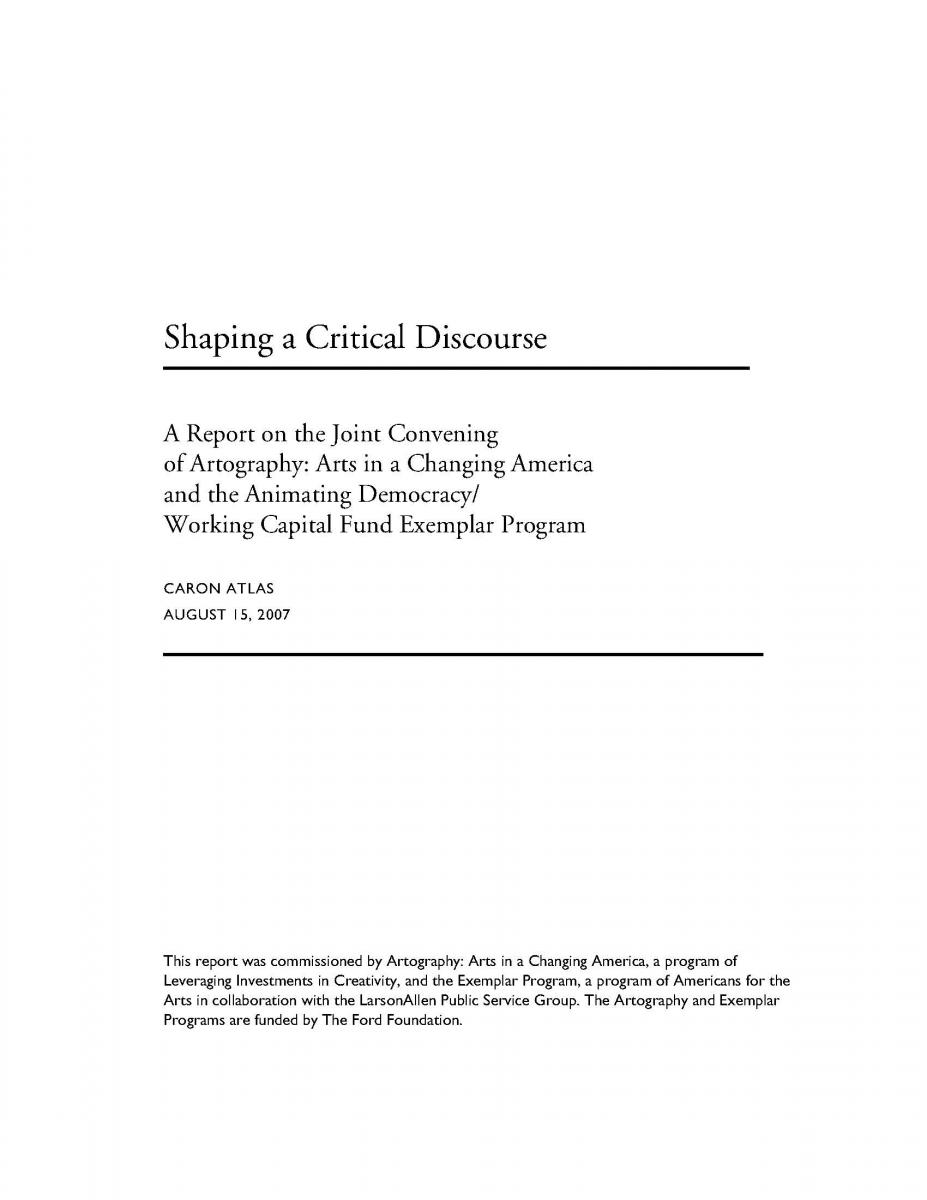 Shaping a Critical Discourse: A Report on the Joint Convening of Artography: Arts in a Changing America and the Animating Democracy/ Working Capital Fund Exemplar Program [PDF]
Shaping a Critical Discourse: A Report on the Joint Convening of Artography: Arts in a Changing America and the Animating Democracy/ Working Capital Fund Exemplar Program [PDF]
by Caron Atlas
Summary: In May, 2007, grantees from the Artography and Animating Democracy/Working Capital Fund Exemplar programs, both supported by The Ford Foundation, met together in Chicago to share their experiences and consider ways they might draw on the collective power of their work. The resulting report, Shaping a Critical Discourse, written by Caron Atlas, explores the topics of aesthetics, new ways of working, and leadership taken up at the cohort-designed gathering. The convening revealed and embraced the creative tensions and contradictions of working in the context of changing demographics, engaging generational shifts and new approaches to collaborative community practices, having diverse value-based structures, and being a cultural agent of change. Session-by-session summaries and resources from the meetings are posted along with the report.
 Report on the Animating Democracy/Working Capital Fund Exemplars Convening
Report on the Animating Democracy/Working Capital Fund Exemplars Convening
December 7 – 9, 2005 - Santa Fe, New Mexico [PDF]
Summary: Representatives of the 12 small and mid-sized organizations participating in Americans for the Arts Exemplar Program convened in December 2005 in Santa Fe New Mexico. Recognized for outstanding cultural work in their communities and in the field based on their participation in Animating Democracy and the Working Capital Fund, the groups explored topic areas related to aesthetic investigation, institutional health and capacity, and civic engagement. From the convening, a report was compiled highlighting the event from beginning to end. With implications for the entire field, the report summarizes key topics areas in relation to challenges and opportunities among cohort members. The Exemplar Program was funded by The Ford Foundation.